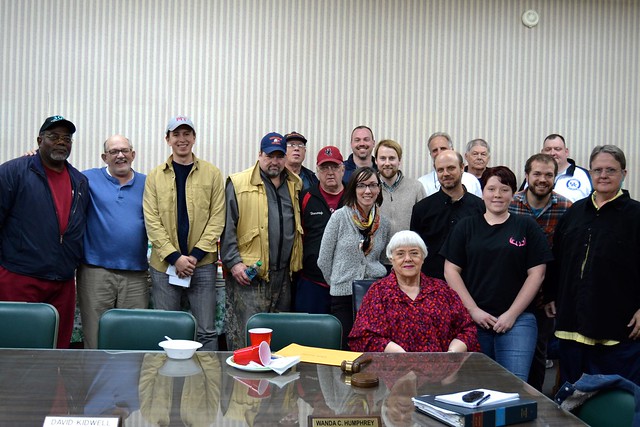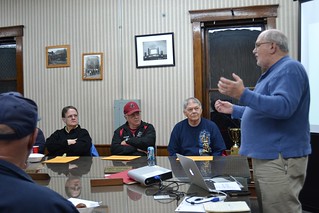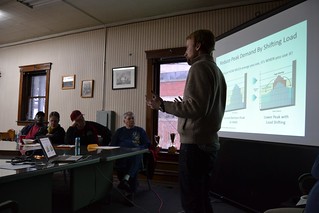Shining a light on Benham Power
 On March 4, the city of Benham in Harlan County took a big step forward in charting its energy future. KFTC, along with the Mountain Association for Community Economic Development (MACED) and MIT, presented research and proposals on how the municipally-owned electric utility in the town can save money on their power bills to their wholesale power provider, as well as help local residents and businesses save energy and money, and help stabilize the town's distribution grid.
On March 4, the city of Benham in Harlan County took a big step forward in charting its energy future. KFTC, along with the Mountain Association for Community Economic Development (MACED) and MIT, presented research and proposals on how the municipally-owned electric utility in the town can save money on their power bills to their wholesale power provider, as well as help local residents and businesses save energy and money, and help stabilize the town's distribution grid.
After the presentations, the town leaders were asked if they were interested in continuing forward with the design and implementation of the project and the response was an overwhelming "yes," with lots of great questions and suggestions shared that evening.
 KFTC leaders in Benham, including Carl Shoupe, Roy Silver and others, have been working for years to bring new energy to this small town at the base of Black Mountain, the highest mountain in the state. The most recent phase of their work began when KFTC members learned that Kentucky Utilities (KU) did not plan to renew its wholesale power contract with the Benham Power Board, starting in 2016.
KFTC leaders in Benham, including Carl Shoupe, Roy Silver and others, have been working for years to bring new energy to this small town at the base of Black Mountain, the highest mountain in the state. The most recent phase of their work began when KFTC members learned that Kentucky Utilities (KU) did not plan to renew its wholesale power contract with the Benham Power Board, starting in 2016.
The KFTC members saw this potential crisis as an opportunity, and in the fall convened a meeting of nonprofits and researchers and others to begin thinking about ways the town could save energy, and produce some of its own energy, as the utility entered into negotiations with new wholesale providers of power.
While Benham's electricity rate is about average in the state, it has the highest per capita electricity usage of any Kentucky utility. Again, this crisis became an opportunity for designing a program that could help residents and the utility itself save significant amounts of energy.
"If Benham can implement this power project in Harlan County, it can be a candle lighting the way for the region, and other towns across the country, to do the same."At the meeting on March 4, Josh Bills of MACED presented research he conducted which showed how much the city was paying for its wholesale power during peak usage – those times, often the very coldest mornings, when the utility is "demanding" power from KU at the highest rate. The utility pays not only for the total amount of energy it consumes (KWh) during the month, but also pays an additional cost each month for its peak demand (KW). If the utility and residents and businesses can find a way to reduce the energy consumed during those peak times each month, the utility could save thousands of dollars each month on their power bills to KU.
Chris Woolery of MACED and Ryan Cook and Brian Bowen, both of MIT, presented strategies for helping to reduce those demand peaks and for helping local residents, businesses, and the city itself save energy and money.
Woolery updated the group on the energy efficiency upgrades performed on local resident Lacey Griffey's home. From January 2013 to January 2014, while the rest of the town's energy costs went up 42%, Griffey's bill declined 56%! While this is an extraordinary example due to the extreme cold of the polar vortex, it shows the impact that a widespread energy efficiency program could have on the town, and how it could help keep money in the pockets of local residents.
Woolery discussed how an on-bill financing program from energy upgrades – similar to MACED's How$martKY program – could do just that: help the town do energy upgrades that pay for themselves and put some savings in the pockets of Benham residents each month.
 MIT wrapped up the meeting with presentations on how small energy improvements (like low-flow shower heads, CFL lights, and water heater blankets, etc.) could add up to significant savings for residents and the utility. They also discussed savings that could be seen by upgrading municipal buildings and other larger users of energy in town, as well as shared their research on ways for funding improvements to the local electrical grid, a major concern of the Power Board.
MIT wrapped up the meeting with presentations on how small energy improvements (like low-flow shower heads, CFL lights, and water heater blankets, etc.) could add up to significant savings for residents and the utility. They also discussed savings that could be seen by upgrading municipal buildings and other larger users of energy in town, as well as shared their research on ways for funding improvements to the local electrical grid, a major concern of the Power Board.
After the local leaders enthusiastically demonstrated their support for going forth and designing a full project, next steps will be pulling together a design team of local leaders, KFTC members and researchers to come up with a plan to formally present to the Power Board. That work took a step forward the following day as MIT and local residents toured the water and waste water treatment plants, substation and other sites to look for ways to begin saving energy and generating energy locally.
As Carl Shoupe said to close the meeting on Tuesday: if Benham can implement this power project in Harlan County, it can be a candle lighting the way for the region, and other towns across the country, to do the same.
Recent News
Kentucky’s past legislative session showed alarming trend toward government secrecy
Churchill Downs takes more than it gives. That's why the Kentucky Derby is a no-go for me
‘We must never forget.’ Kentucky town installs markers for lynching victims.
Featured Posts
Protecting the Earth
TJC Rolling Out The Vote Tour – a KFTC Reflection Essay
KFTC Voter Empowerment Contractor Reflection Essay
Archives
- Home
- |
- Sitemap
- |
- Get Involved
- |
- Privacy Policy
- |
- Press
- |
- About
- |
- Bill Tracker
- |
- Contact
- |
- Links
- |
- RSS


Add new comment